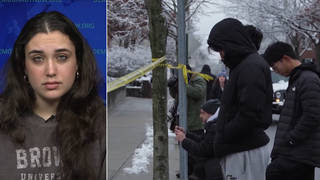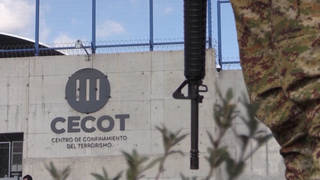
Topics
Guests
- Sister Dianna Ortiza Catholic nun who was abducted and tortured by security forces while working as a missionary in Guatemala. She is the founder of the Torture Abolition and Survivors Support Coalition International.
Torture survivors from all over the world on Saturday gathered in front of the White House to mark the 10th anniversary of the U.N. Day in Support of Torture Victims and Survivors. The survivors are all members of the Torture Abolition and Survivors Support Coalition, or TASSC, the only organization in the United States made up of survivors of torture. [includes rush transcript]
Transcript
AMY GOODMAN: Torture survivors from around the world gathered Saturday in front of the White House to mark the tenth anniversary of the U.N. Day in Support of Torture Victims and Survivors. The survivors are all members of the Torture Abolition and Survivors Support Coalition, or TASSC, the only organization in the United States made up of survivors of torture.
TASSC chose to do this year’s vigil at the White House to officially launch its campaign to repeal the Military Commissions Act, which survivors of torture have renamed the Torture Law.
Sister Dianna Ortiz is the founder of TASCC. In 1989, she was abducted by Guatemalan security forces while working as a missionary among indigenous people in Guatemala. She was taken to a secret prison in the capital center and brutally tortured. She was burned with cigarettes over a hundred times. She was raped. She was beaten. And she was forced to torture and kill a woman who was already near death. Sister Ortiz was the main organizer of this weekend’s 24-hour vigil in front of the White House. She joins us now from Washington, D.C. Sister Dianna Ortiz, welcome to Democracy Now!
SISTER DIANNA ORTIZ: Thank you, Amy.
AMY GOODMAN: Thank you so much for joining us. I know that your voice is very, very sore, so we’ll just listen carefully as you whisper. Describe why you went to the White House on Saturday.
SISTER DIANNA ORTIZ: Torture survivors from TASSC International have declared June as Torture Awareness Month. And we believe that it’s very important to raise awareness about the plight of torture in our world today. There are more than 150 governments engaged in torture today, including the United States government. We believe that the United States government and the American people need to know about the seriousness of this horrible crime against humanity. We decided that we would hold our 24-hour vigil on Saturday to draw more attention to the public. We are trying to do whatever we can to break the silence against torture.
AMY GOODMAN: I wanted to read from today’s Washington Post. “The vice president’s office played a central role in shattering limits on coercion in U.S. custody, commissioning and defending legal opinions that the Bush administration has since portrayed as the initiatives, months later, of lower-ranking officials. Cheney and his allies, according to more than two dozen current and former officials, pioneered a novel distinction between forbidden 'torture' and permitted use of 'cruel, inhuman or degrading' methods of questioning. They did not originate every idea to rewrite or reinterpret the law, but fresh accounts from participants show that they translated muscular theories, from [John] Yoo and others, into the operational language of government. A backlash beginning in 2004, after reports of abuse leaked out of Iraq’s Abu Ghraib prison and Guantanamo Bay, brought what appeared to be sharp reversals in courts and Congress — for both Cheney’s claims of executive supremacy and his unyielding defense of what he called 'robust interrogation.'” Your response, Sister Dianna Ortiz?
Dianna? Dianna, are you still with us in Washington? Can you hear us, Dianna? We may have lost Sister Dianna Ortiz.
I’ll read a little more from the Washington Post piece. This is a piece that’s an ongoing series on the vice president, on Vice President Dick Cheney. And it says, “A more careful look at the results suggests that Cheney won far more than he lost. Many of the harsh measures he championed, and some of the broadest principles undergirding them, have survived intact but out of public view. […] No longer was the vice president focused on procedural rights, such as access to lawyers and courts. The subject now was more elemental: How much suffering could U.S. personnel inflict on an enemy to make him talk? Cheney’s lawyer [David Addington] feared that future prosecutors, with motives 'difficult to predict,' might bring criminal charges against interrogators or Bush administration officials.”
What about, Sister Dianna Ortiz, the White House’s role — today’s Washington Post piece is about the centrality of the vice president’s office — in this issue of torture and defining torture?
SISTER DIANNA ORTIZ: Unfortunately, I have not read the article, but what I’m hearing right now makes me so angry that our government is allowing the president and the vice president and other important government officials to be engaged in torture. And I’m outraged, as with other survivors, that members of Congress, our leaders, are just standing by and letting this crime be —
AMY GOODMAN: I know, Sister Dianna Ortiz, this is incredibly difficult for you, that you live with this every day, not only that you went through what you went through in Guatemala, but that you have committed your life to working with other torture survivors from around the country and the world. I’m wondering how you respond to the administration’s argument that you are preventing greater crimes — that the administration is preventing greater crimes by being involved in these interrogations, because they’re trying to get information out of terrorists that could prevent a greater crime. Your response?
SISTER DIANNA ORTIZ: Torturing another person does not result in getting information.
AMY GOODMAN: Can you talk, Dianna, about who came to the White House? Who are the other people from around the world who joined you?
SISTER DIANNA ORTIZ: We had torture survivors from Nigeria, Peru, Colombia, Iran, Iraq, the Philippines — I apologize. This is just very difficult.
AMY GOODMAN: And I know that you have — you spent — it was a 24-hour vigil in front of the White House, and it’s a series of days that you’ll be involved with this, culminating in tomorrow, which is the 10th anniversary of the United Nations [Day in Support of Torture Victims and Survivors]. Explain what the torture convention is, passed by the U.N. General Assembly, if you can.
Dianna, can you hear me? We seem to have lost her again. Sister Dianna Ortiz, I want to thank you for being with us. I know that this is very hard for you. Of course, we will continue to follow this issue. There are actions planned in Washington and New York and other places around the issue of torture. Thank you so much for being here, Sister Dianna Ortiz, a Catholic nun who was abducted and tortured by Guatemalan security forces, working as a missionary in Guatemala. She is founder of the Torture Abolition and Survivors Support Coalition.













Media Options